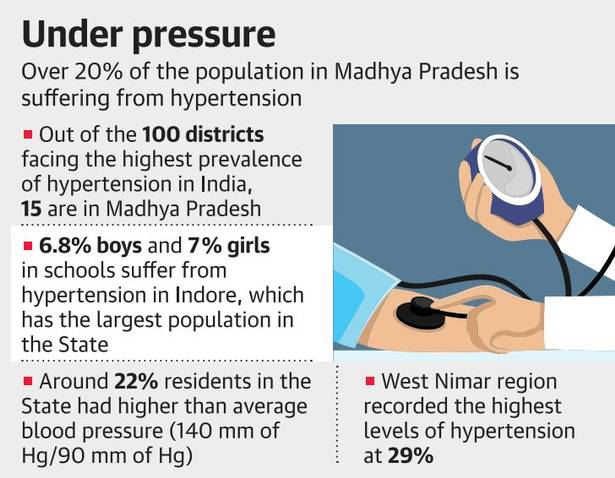Social Justice
Incidence of NCDs in MP
- 27 Jan 2020
- 4 min read
Why in News
Recently, a screening drive was carried out by the National Health Mission (NHM) under the Centre’s Non-Communicable Disease Control Programmes in Madhya Pradesh.
Key Points
- Non-communicable diseases like hypertension, diabetes and cancer are posing a bigger challenge in the non-tribal rural areas of Madhya Pradesh owing to a rapidly growing rate of incidence and the lack of awareness.
- Urban areas have more awareness which translates into patients undergoing treatment despite a high incidence and the burden is moderate.
- However, the burden is increasing in rural areas due to low awareness.
- It needs to be noted that despite the low awareness levels, there was a low incidence in the 89 tribal blocks in the State, which has the largest tribal population in the country.
- Of the country’s 100 districts with the highest prevalence of hypertension, 15 were in Madhya Pradesh.
- The India Hypertension Control Initiative, supported by the World Health Organisation (WHO), is catering to patients above 18 suffering from the diseases in various districts of the state.
Non-Communicable Disease Control Programmes
- It is a group of various national programmes which focus on different non-communicable diseases separately. For example- National Mental Health Programme, National Oral Health Programme, National Tobacco Control Programme, etc.
- The programmes focus on identifying non-communicable diseases at the Primary Health Centre (PHC) level itself and ensuring treatment up to the district-level and follow-ups with patients to continue medication.
- Also, Accredited Social Health Activist (ASHA) workers go door-to-door to draft family profiles and screen them for the non-communicable diseases instead of patients visiting a health centre.
India Hypertension Control Initiative
- It is a collaborative project of Indian Council of Medical Research (ICMR), Ministry of Health and Family Welfare (MoHFW), State Governments, WHO and ‘Resolve to Save Lives’- initiative of Vital Strategies.
- It was launched in November 2017 in 25 selected districts in Punjab, Madhya Pradesh, Kerala, Telangana, and Maharashtra. It was expanded to cover 100 districts across all states in 2019.
- The primary goal of this project is to reduce morbidity and mortality due to cardiovascular diseases (CVDs), the leading cause of death in India, by improving the control of high blood pressure, which is a leading risk factor for CVDs among adults in India.
- It aims to:
- Create patient-centred services to improve patient support.
- Reduce reliance on bigger hospitals and an increase in the utilization of ‘Health and wellness centres’ and primary health centres.
- Provide for regular monitoring of health facilities and prompt feedback to program managers to bridge gaps if any in a timely manner.






